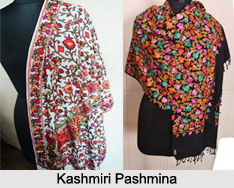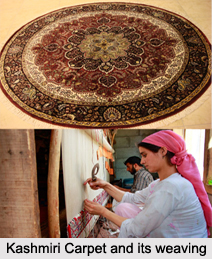 The much prized Kashmiri handicrafts also encompass textiles comprising Kashmiri carpets, both of wool and silk with their Persian designs, beautiful woollen shawls, crewel embroidery on furnishing material sold by the meter, all of which are vibrantly displayed in the array of shops lining the streets of Srinagar.
The much prized Kashmiri handicrafts also encompass textiles comprising Kashmiri carpets, both of wool and silk with their Persian designs, beautiful woollen shawls, crewel embroidery on furnishing material sold by the meter, all of which are vibrantly displayed in the array of shops lining the streets of Srinagar.
Kashmiri Pashmina
Pashmina is synonymous with Kashmir; hence was called "cashmere" when it spread to the west. A luxury fabric woven in the region since decades, Kashmiri Pashmina is a combination of both material and traditional process. Developed and refined by the Kashmiri artisans to make the fabric of incredible lightness, strength and lustre, this process is believed to retain the uniqueness of Pashm - the reason why bona fide Pashmina cannot be woven on machines.
A morning at the master weaver"s studio understanding the process of Pashmina weaving from the fibres of Pashm that is 1/10th the width of human hair, to spinning gossamer-like yarns and weaving finest fabrics known to man is worth an experience in Kashmir.
Shawls
The Kashmiri shawl is the most cherished acquisition of a lady. The traditional and contemporary designs, patterns, colours and embroidery being used in these shawls suit the style and accentuate the individuality of the wearer. Kani Shawl is the very Kashmiri craft that takes several thousands of lines for two metres of shawl to be woven. The weaver recites a Persian script of instructions with each line of weave. This tapestry technique using hundreds of wooden kanis with coloured Pashm yarn to create the designs on the loom is a must visit.
Carpets
Carpet weaving in Kashmir in India arrived with the Mughals. The craft flourished in Kashmir and the place has today become a hub for quality rugs. The patterns are influenced by the Persian style blended with Indian version. One typical Kashmiri Indian pattern is the tree of life. While most carpet weaving has shifted to the countryside, carpet workshops can be spotted in the heart of Srinagar, where weavers knot 900 times in a square inch. Fine silk and wool carpet weaving, introduced by the Persians during the 14th century, has flourished in Kashmir since the Mughal times and is still among the most expensive in the world. Traditional Persian designs and motifs are hand knotted on a simple vertical loom, reciting a "talim", the written design script of instructions. The designs are still named after famous Persian cities, such as Kashan and Hamdaan.
Namdahs
 Far less expensive than the carpets are the Namdahs, which are excellent and vibrant floor coverings for winters, made by felting together layers of wool and cotton fibre and manually pressed into shape. Prices vary with the percentage of wool - a Namdah containing 80 per cent wool being more expensive than the one containing 20 per cent wool. Chain stitch embroidery in woollen and cotton thread is worked on these rugs. A specialty of Yarkand during the Mughal times, the Kashmiri embroidered Namdahs became renowned in the last century and it is fascinating to actually see this unique felting process being done by foot even today in the old part of the city.
Far less expensive than the carpets are the Namdahs, which are excellent and vibrant floor coverings for winters, made by felting together layers of wool and cotton fibre and manually pressed into shape. Prices vary with the percentage of wool - a Namdah containing 80 per cent wool being more expensive than the one containing 20 per cent wool. Chain stitch embroidery in woollen and cotton thread is worked on these rugs. A specialty of Yarkand during the Mughal times, the Kashmiri embroidered Namdahs became renowned in the last century and it is fascinating to actually see this unique felting process being done by foot even today in the old part of the city.
Chain Stitch and Crewel Furnishings
One of the specialties of the gifted master craftsmen of Kashmir is Chain Stitched embroidery, also known as Aari embroidery. Chain stitch is one of the oldest of the decorative stitches and is the basis of a large group of stitches. Quite unlike the fine needle embroidery on shawls, Aari work is another kind of traditional embroidery done mostly by women with the help of a hooked needle or an awl. Shawls, pherans and other apparels are embroidered with fine cotton threads, but the same embroidery is also called crewel work when used on thick draperies and upholstery with coarser dasuti fabric and woollen yarns. The fully worked chain stitch rugs, cushions and leather embroidered accessories with intricate kilm and floral designs are distinctly treasured gifts to take back from Kashmir.
Silks and Tweeds
Sericulture and tweed weaving are more important industries in Kashmir, with departments of the state government closely monitoring the process. Interestingly, just as little or no raw material for tweed comes from Kashmir, almost no weaving and printing of silk is done in the state. However, the cocoon reared in Kashmir is of the superior quality, yielding an extremely fine fibre, and any silk woven from this thread becomes known. The fineness of the yarn lends itself particularly well to the weaves known as `chinon` and `crepe de chine`, in addition to the universally recognised silk weave. Tweed on the other hand is woven in Kashmir with pure, never blended wool. The resultant fabric, made with imported know-how, compares favourably with the best in the world. It is available by the length occasionally as ready to wear garments.
Pherans
This garment, somewhere between a coat and a cloak, is eminently suited to the Kashmiri style of life, being loose enough to admit the inevitable brazier of live coals which is carried around in much the same way as a hot water bottle. Men`s pherans are always made of tweed or coarse wool; women`s pherans, somewhat more stylized, are most commonly made of raffel, which splashes of Aari or hook embroidery at the throat, cuffs and edges. The quality of embroidery and thickness of the raffel determines the price.
Sozni Embroidery
A craft introduced by mystics and Sufis, Sozni is the needle embroidery with a unique darning stitch and is considered a meditative practice even today to immerse oneself in the divine.
The master embroider works with a single strand of silk on Pashmina and spends years in embellishing each Jamavaar shawl with intricate designs and motifs. The mystical almond buteh, the signature motif for all fine Kashmiri shawls, later became the "paisley" after its imitations were produced in England.
Tilla Embroidery
The Tilla embroidery with yarns of gold and silver zari is another distinct ornamentation on pherans and shawls, the best of them being found around Zaina Kadal and a must in every Kashmiri girl"s trousseau. The gold yarn called Tilla is arranged in intricate swirls and held down with minute stitches like a couching stitch.
Related Articles:
Jammu and Kashmir
Crafts of Jammu and Kashmir
Tribes of Kashmir
Art of Kashmir
Material Crafts of Kashmir
Costumes of Jammu and Kashmir
Kashmiri Pashmina
Kashmiri Carpets
Chain Stitch and Crewel Furnishings of Kashmir
Needle Craft Embroidery



















